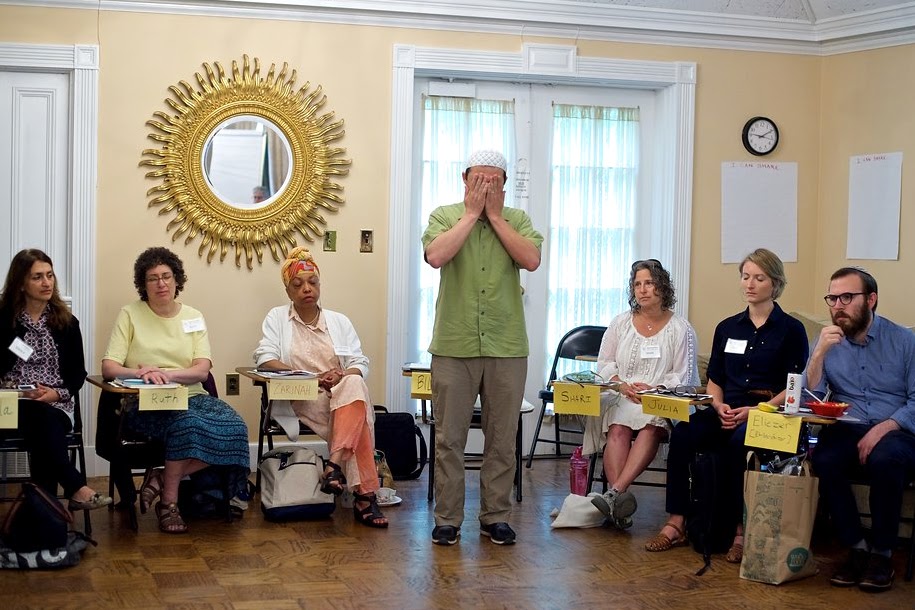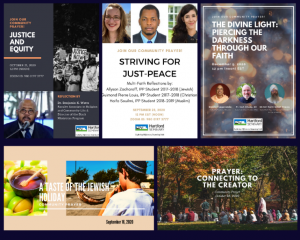Praying with the Other: A Reflection on Community Prayer at Hartford Seminary

One of my earliest memories in elementary school is the prayer that all students recited at the very beginning of the day. This was in Indonesia, where I grew up. I cannot remember the exact wording, but it was very brief and straightforward, something like: “O God, bestow upon us intelligence so that we may study well today.” The class consisted of students from different religious backgrounds.
In Indonesia, praying with the other, i.e., people of different religious identities, is ordinary. As the country with the largest Muslim population, yet very religiously diverse, public prayer is one way to build tolerance and respect. If someone is invited to lead a prayer in a public event that has a mixed audience, then the person will state, “please allow me to lead the prayer in a Christian [or Muslim or something else] way. Let us pray.” There are occasions where different religious leaders are invited to pray in accordance with their religious identity. The latter model can also be found in multifaith gatherings in the United States.
Praying with others is not easy for some people. One may refuse to join because it feels like betraying their religious precept, because of the fear of syncretism, or just because it feels weird. There are reasons for not doing it. But there are also reasons why praying with people of other religions is spiritually rewarding, uplifting, and nourishing. I will not make a case that will convince all people and stop the debate once and for all. Instead, I will share my experience with Hartford Seminary’s community prayer as a space for people of different religious beliefs and non-religious people to gather regularly.
Seeking the Divine, Embracing the Other: Nurturing a Holistic Spirituality
Since Fall 2020, when I joined my alma mater as a visiting professor, I have had the privilege to organize community prayer every Wednesday. It is a privilege because I connect with and glean insights from extraordinary people with deep spirituality, both speakers and participants. Like many other events in the world we live in, the weekly prayer is conducted virtually through Zoom.
Hartford Seminary is a unique institution for its diverse community, including its multifaith environment. It is a seminary where people of different faith traditions learn together. Yet, Hartford Seminary has more to offer than religious diversity. Its diversity results from constant and painstaking efforts of nurturing for decades to be the core of its being.

From the very beginning, I envisioned the community prayer to be a testament to our institution’s unique identity. On the one hand, the goal was to nurture spirituality in a holistic way, i.e., where one connects to the Divine, others, and all creations. On the other hand, it must represent things and values the community continues to struggle for in the world we live today. Issues like racial justice, economic equity, ecological awareness, and peacebuilding are combined with various themes related to how people of different religious traditions understand and practice their faith. The purpose of prayer is to seek connection with the Divine. At the same time, prayer brings humans together, reminding them of their shared vulnerabilities, values, goals, and interrelations with one another and with all creation.
Interreligious Hospitality
Hartford Seminary’s community prayer sessions are designed to be accessible and inclusive of all. The format and focus of the service changes and takes the shape of the tradition of the leader each week. Attendees who do not identify with a particular tradition are encouraged to attend and be participant observers as their comfort level allows. Therefore, there are different types of sessions: some are based on one religious tradition while others are intentionally interreligious. Openness remains a vital key, so although a session is based on one religious tradition, it should provide space for “guests,” i.e., people of different faith traditions or even those who identify as religious “nones.” Interreligious hospitality becomes the foundation of all meetings.
Douglas Pratt identifies hospitality as one of the modes of interreligious prayer. It “signifies events that are ‘inner facing,’ in the sense of a hospitable communal ingathering of persons of different religions, on occasions wherein the reciprocal roles of host and guest set the parameters for interaction” (Pratt). The reciprocity is demonstrated when people of different religious traditions take a turn in becoming the host for various sessions and guests in other sessions. Therefore, the role of the host is not monopolized or dominated by one tradition.
Moreover, the roles of host and guest are not static. The host may receive spiritual insights even when she is supposed to be the one who shares them. This experience is rooted in the nature of the practice of hospitality: giving and sharing do not exhaust or diminish the things being given but rather make them more abundant for all. Hartford Seminary programs use this basis of interreligious interrelations to foster interfaith cultural leaders who value the strengths of living in, learning from, and serving diverse communities. Our MA in Interreligious Studies program is designed to immerse students in the lived reality of religions and the relationships between different faiths, while deepening their knowledge of their own — much like how by praying with one another, we both realize our similarities and learn to appreciate our differences. Similarly, our MA in Peacebuilding program builds knowledge in interreligious peace studies by using experiential learning to examine historical and present-day conflict and build relationships across the lines of difference.
Tags: building interfaith community through multifaith prayer
